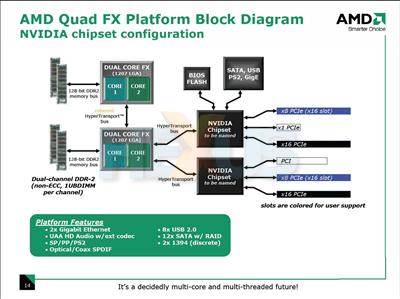What's it all about?
Quad FX may have four cores but they're distributed over two entirely separate processors in two different sockets. In contrast, Intel has squeezed its pair of dual-core processors into one package to make the Core 2 Extreme QX6700. The disadvantage of the latter is that both dual-core processors share the same Front Side Bus, and can't talk to each-other directly even though they're physically adjacent. This, in theory, could cause a data bottleneck. But in practice we have found that there are still plenty of performance benefits to be had from Core 2 'Quad' over Core 2 Duo, with the right applications.
AMD's arrangement is supposedly more efficient than Intel's. The two dual-core processors have their own dedicated bank of memory each - although the operating system (in theory) sees this as one block. The two processors can still get to the memory associated with the other processor via a HyperTransport link between the two processors. This is a special type of Coherent HyperTransport link which allows one processor to command the memory controller on the other - and even obtain data from the other CPU's cache. However, only one processor is directly attached to the rest of the system. In the case of the Nvidia 680a SLI chipset in the launch Quad FX platform, one HyperTransport link goes to each of the two chips in the Nvidia core logic, with peripherals fairly evenly split between them.
Unfortunately, the two banks of memory also cause one of the potential problems with AMD's Quad FX. The operating system needs to support its Non-Uniform Memory Architecture (NUMA). Windows XP SP2 does, either via a /PAE boot.ini entry or by default if processors with an Execute Disable bit are detected (which includes all AMD 64-bit CPUs). However, Windows Vista has been engineered to work much more seamlessly with NUMA. So performance should be better with the new Microsoft operating system.
As we reported in our first article, there are three processors in the Quad FX range - FX-70, FX-72 and FX-74. These run at 2.6GHz, 2.8GHz and 3GHz respectively. So the FX-74 on its own would be the fastest dual-core processor currently available from AMD. But the CPUs will only be sold as matched pairs with the appropriate HSF, and AMD claims the FX-74 pair will be $999, comparable to Intel's Core 2 Extreme QX6700. However, these are Socket L1FX processors (aka the 1207-pin Socket F used with AMD's Opteron), so you won't be able to buy a pair and pop them into a couple of Socket AM2 systems instead.










